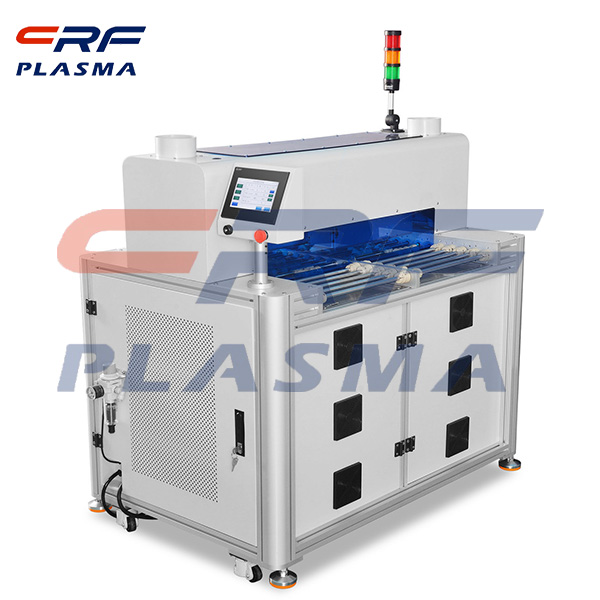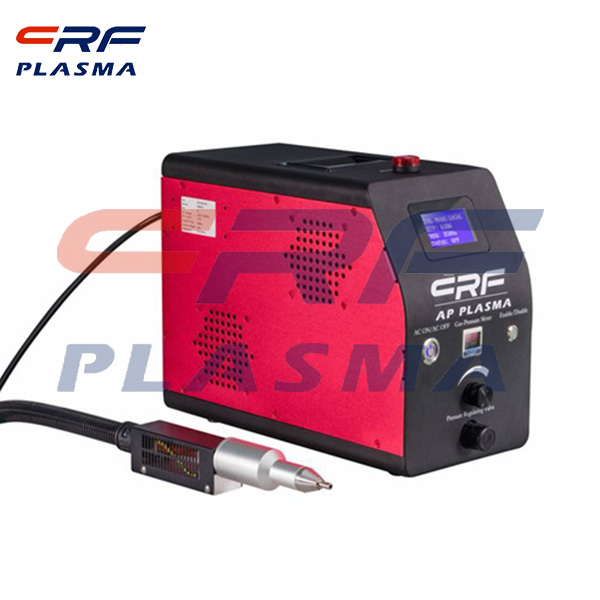
Welcome to Shenzhen Sing Fung Intelligent Manufacturing Co., Ltd.
E-mail:shaobo@sfi-crf.com
Glass plasma surface treatment
- Categories:Industry News
- Author:plasma cleaning machine-surface treatment equipment-CRF plasma machine-Sing Fung Intelligent Manufacturing
- Origin:
- Time of issue:2020-11-23
- Views:
(Summary description)Glass has been used as a material for centuries. Due to the chemical inertia of the glass and its stable properties under the influence of the environment, the glass substrates are cleaned and dried by conventional cleaning methods, so it is difficult to completely remove the foreign bodies adsorbed on the surface. In addition, the surface will be exposed to the air during transportation and handling, which will inevitably adsorb the ambient gas, water vapor and particles. If left untreated, it will lead to insufficient binding force between the film layer and the substrate, resulting in pinholes and particles. After being cleaned and treated by plasma surface treatment machine, the glass material can enter into the next process immediately. Therefore, plasma surface treatment of glass is a stable and effective process. Plasma surface treatment machine modification, the processing technology of glass has simple equipment, low raw material consumption, low cost, high value-added products, glass coating, adhesive, membrane process was optimized, the low temperature plasma surface treatment machine modified material has been widely used in capacitive, resistive touch screen mobile phone, such as some need to finish machining of glass. After plasma treatment, the glass can reach a point of 72 dyne or even higher, and the water drop Angle can be reduced to less than 10 degrees. It solves the difficulties of glass bonding, printing, electroplating and other problems. In the plasma, as the glass substrate is bombarded by the charged energy particles (electrons) in the plasma, the ambient gas, water vapor and dirt adsorbed on the surface of the substrate are first bombarded to activate them, make the surface clean and improve the surface energy. When the substrate is deposited, the film atoms or molecules are immersed in the surface to increase van der Waals force. The second is that the surface of the glass substrate is impacted by the charge particles (electrons). Under such impact, many pits and pores will be formed on the surface of the glass substrate. In the deposition process, atoms or molecules in the film enter into these grooves and pores, thus generating mechanical locking force. In addition, the coarsening of the substrate surface increases the actual surface area, which is beneficial for increasing van der Waals forces (intermolecular forces), diffused adhesion, and electrostatic adhesion, thus increasing the total adhesion. After plasma surface treatment of glass, the surface of the substrate can be cleaned and activated, and the surface can be improved. It can not only effectively remove the environmental gas molecules, water vapor and pollutants adsorbed on the substrate, but also form a clean and activated micro rough surface on the surface of the substrate, and avoid secondary pollution.
Glass plasma surface treatment
(Summary description)Glass has been used as a material for centuries. Due to the chemical inertia of the glass and its stable properties under the influence of the environment, the glass substrates are cleaned and dried by conventional cleaning methods, so it is difficult to completely remove the foreign bodies adsorbed on the surface. In addition, the surface will be exposed to the air during transportation and handling, which will inevitably adsorb the ambient gas, water vapor and particles. If left untreated, it will lead to insufficient binding force between the film layer and the substrate, resulting in pinholes and particles. After being cleaned and treated by plasma surface treatment machine, the glass material can enter into the next process immediately. Therefore, plasma surface treatment of glass is a stable and effective process.
Plasma surface treatment machine modification, the processing technology of glass has simple equipment, low raw material consumption, low cost, high value-added products, glass coating, adhesive, membrane process was optimized, the low temperature plasma surface treatment machine modified material has been widely used in capacitive, resistive touch screen mobile phone, such as some need to finish machining of glass. After plasma treatment, the glass can reach a point of 72 dyne or even higher, and the water drop Angle can be reduced to less than 10 degrees. It solves the difficulties of glass bonding, printing, electroplating and other problems.
In the plasma, as the glass substrate is bombarded by the charged energy particles (electrons) in the plasma, the ambient gas, water vapor and dirt adsorbed on the surface of the substrate are first bombarded to activate them, make the surface clean and improve the surface energy. When the substrate is deposited, the film atoms or molecules are immersed in the surface to increase van der Waals force. The second is that the surface of the glass substrate is impacted by the charge particles (electrons). Under such impact, many pits and pores will be formed on the surface of the glass substrate. In the deposition process, atoms or molecules in the film enter into these grooves and pores, thus generating mechanical locking force. In addition, the coarsening of the substrate surface increases the actual surface area, which is beneficial for increasing van der Waals forces (intermolecular forces), diffused adhesion, and electrostatic adhesion, thus increasing the total adhesion.
After plasma surface treatment of glass, the surface of the substrate can be cleaned and activated, and the surface can be improved. It can not only effectively remove the environmental gas molecules, water vapor and pollutants adsorbed on the substrate, but also form a clean and activated micro rough surface on the surface of the substrate, and avoid secondary pollution.
- Categories:Industry News
- Author:plasma cleaning machine-surface treatment equipment-CRF plasma machine-Sing Fung Intelligent Manufacturing
- Origin:
- Time of issue:2020-11-23 09:20
- Views:
Glass plasma surface treatment:
Glass has been used as a material for centuries. Due to the chemical inertia of the glass and its stable properties under the influence of the environment, the glass substrates are cleaned and dried by conventional cleaning methods, so it is difficult to completely remove the foreign bodies adsorbed on the surface. In addition, the surface will be exposed to the air during transportation and handling, which will inevitably adsorb the ambient gas, water vapor and particles. If left untreated, it will lead to insufficient binding force between the film layer and the substrate, resulting in pinholes and particles. After being cleaned and treated by plasma surface treatment machine, the glass material can enter into the next process immediately. Therefore, plasma surface treatment of glass is a stable and effective process.
Plasma surface treatment machine modification, the processing technology of glass has simple equipment, low raw material consumption, low cost, high value-added products, glass coating, adhesive, membrane process was optimized, the low temperature plasma surface treatment machine modified material has been widely used in capacitive, resistive touch screen mobile phone, such as some need to finish machining of glass. After plasma treatment, the glass can reach a point of 72 dyne or even higher, and the water drop Angle can be reduced to less than 10 degrees. It solves the difficulties of glass bonding, printing, electroplating and other problems.
In the plasma, as the glass substrate is bombarded by the charged energy particles (electrons) in the plasma, the ambient gas, water vapor and dirt adsorbed on the surface of the substrate are first bombarded to activate them, make the surface clean and improve the surface energy. When the substrate is deposited, the film atoms or molecules are immersed in the surface to increase van der Waals force. The second is that the surface of the glass substrate is impacted by the charge particles (electrons). Under such impact, many pits and pores will be formed on the surface of the glass substrate. In the deposition process, atoms or molecules in the film enter into these grooves and pores, thus generating mechanical locking force. In addition, the coarsening of the substrate surface increases the actual surface area, which is beneficial for increasing van der Waals forces (intermolecular forces), diffused adhesion, and electrostatic adhesion, thus increasing the total adhesion.
After plasma surface treatment of glass, the surface of the substrate can be cleaned and activated, and the surface can be improved. It can not only effectively remove the environmental gas molecules, water vapor and pollutants adsorbed on the substrate, but also form a clean and activated micro rough surface on the surface of the substrate, and avoid secondary pollution.

Scan the QR code to read on your phone

TEL:0755-3367 3020 / 0755-3367 3019

E-mail:sales-sfi@sfi-crf.com

ADD:Mabao Industrial Zone, Huangpu, Baoan District, Shenzhen


















